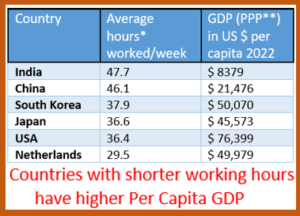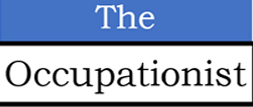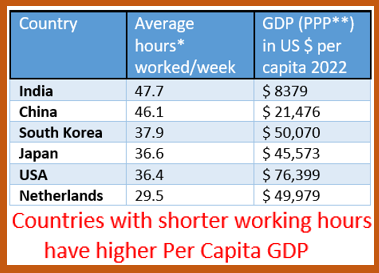Recently one of India’s IT leader and Infosys founder NR Narayana Murthy, whom many including me hold in high esteem, sparked a debate when he spoke about working for 70-hours per week.
In the past, many Indian leaders have voiced similar views. Bhavish Aggarwal, CEO of Ola went on to say that it is ‘our moment to go all in and build in one generation what other countries have built over many generations.’
Shantanu Deshpande, the CEO of Bombay Shaving Company, had said in a LinkedIn post that freshers should work 18 hours per day. ‘Eat well and stay fit, but put in the 18-hour days for at least 4-5 years,’ he said. Some sage advice but he was trolled in social media and eventually had to apologise and say that it was not meant to be taken literally.
Some global leaders also pitch for similar hours. Chinese businessman Jack Ma of Alibaba had the 996 rule, that is, work from 9 am to 9 pm 6 days a week. In China, Jack Ma was criticized by social media users saying that it will affect family life, and no one will have children because of lack of time.
Elon Musk, world’s richest man and CEO of many companies including Twitter (now X) asked the Twitter staff to work more than 100 hours per week.
If the employee was hired at a 40-hour salary, companies will have to budget this in their expenditure because you can’t demand a 70-hour week at a 40-hour salary.
Now, what is wrong in a 70-hour week or 12-hours day. Nothing really, if you are working for your own company or start-up, are working on a project that is for a few weeks and if you enjoy the entire experience. Basically, if you have a sense of purpose, it won’t harm or kill you prematurely. Death is a multi-factorial journey and work (both overwork and underwork) is just one of its reasons. However, both, overwork and underwork can have disastrous effect on mind and body, especially if it is against the wish of the employee and goes on for a long time, and any good work culture should account for that.
Those who want to work or have to work 70 hours or more are already doing so, routinely. For those who want to work it is a matter of choice, for those who have to work it is matter of survival.
Working 70 hours or more per week can’t be a rule. It can be an exception though. We live in an orderly world – there is WHO and there is ILO. The work guidelines of these two global bodies must be respected.
Indian worker is already working 47.7 hours per week on an average, according to International Labour Organization (ILO) data updated in 2023. In a comparison of 10 big economies, Indians have the longest average work week. India ranks 7th in the global ranking with only Qatar, Congo, Lesotho, Bhutan, Gambia, and the United Arab Emirates averaging more, which is what makes the ILO prepare a special India-specific report on working hours.
Most workers will not be happy to work for 70 hours per week. This will lead to a lot of unhappiness, which in turn will lead to lot of diseases, low productivity and defeat the very idea of creating national wealth. The wealth created will be less due to low productivity and whatever wealth is produced will go into treating the diseases caused by unhappiness due to 70 hours workweek.
Meanwhile, a survey done in 2018 by Harvard Business Review said that CEOs in the US work 9.7 hours per weekday, and another 3.9 hours per weekend day, that is almost 53 hours per week. They also work during vacations. And they do it week after week till they are at the helm of affairs.
A one-day break taken by a CEO during a crisis can cost him/her the job as it happened during the Gulf of Mexico oil spill in 2010.
Another survey of 357 Indian CEOs of listed Indian manufacturing firms by International Growth Centre (economic research outfit) revealed that the average Indian CEO works 39 hours a week. This meant most CEOs work for close to 8 hours a weekday.
It is interesting to note that countries with shorter working hours have higher Per Capita GDP (see the table below):

*Source: ILO (International Labour Organization)
**PPP (Purchasing Power Parity) takes into account relative cost of living, rather than using only exchange rates, therefore providing a more accurate picture of real differences in income. Source: worldometers.info
All this reminds me of two stories, one of Steve Jobs, a real character and another Tom Sawyer, a fictional one created by Mark Twain in 1876.
Tom Sawyer, an orphan boy full of mischief but pure-hearted, gets punished by Polly, his aunt because he angers her by eating jam and then getting into fight with another boy. The punishment is to whitewash the fence, an unpleasant task in his eyes. However, Tom gets a number of other boys to whitewash the fence by convincing them that whitewashing is fun. By making the work look extremely absorbing, Tom, an all-American boy not only gets the work of whitewashing the fence but the boys end up giving him various items for a turn at the fence.
On the other hand, Steve Jobs, founder of Apple and an all-American boy with an Indian philosophy influence, had once bragged to the press that the MacIntosh team was working 90 hours a week. Obviously, MacIntosh was Apple’s first computer for mass consumption and so a lot had to be done. Steve would call his engineers on holidays and weekends because they felt the experience of working with him was worth it. The engineers could not resist working with Steve Jobs.
After being sacked from Apple, the company that Steve created, he returned to Apple in 1996 and worked from 7 am to 9 pm every day, since he was also leading Pixar (another company he created when he was sacked from Apple) operations. All those extended hours were put by Steve because Pixar was his company and he was passionate about work in general. No one told Steve Jobs to work extended hours; no one could tell him!
Only if managers and CEOs are like Tom or Steve will some of the employees voluntarily work more than ILO-scheduled 40 hours per week in case a time-bound project has to be completed. However, it cannot go on day after day endlessly.
Rather than hours, one should focus on quality of work, management techniques to get quality work done better and engineering methods to do quality work faster and cheaper. Cheaper, better, faster is the mantra of manufacturing.
Those who want to work or have to work 70 hours or more are already doing so, routinely. For those who want to work it is a matter of choice, for those who have to work it is matter of survival. To name a few of them – homemakers, working women managing homes, single parents, doctors, gig workers (a person who does temporary work, freelance work, or anyone engaged in an informal work on-demand basis or those who work on a part-time basis to earn supplementary income), migrant workers engaged in farming and construction, aspiring sportspersons, research scholars etc.
The statement by Narayana Murthy and the consequent debate about working hours is actually a good one as it raises questions about work, occupational (work-related) health, gender roles, and societal expectations. At a time when mental health is being recognized in India as a risk to be mitigated, and as India continues to evolve, it is necessary that the debate around workers, gender equality, work-related (occupational) health impacts and work-life balance continues and produces solutions that are doable for the employees in India.
As an Occupational Health physician, it would not be appropriate for me to advise either the management or the employees to work beyond ILO-stipulated 40-hours per week. This is because I see a risk in overwork and my role as a physician is to mitigate those risks rather than aggravate it or create new ones and then find solutions which wouldn’t be any different than reducing work hours and a host of others due to indirect damages.
In my world, I would advocate a 945 rule – work from 9 to 4, 3 days in a week in office, 2 days in a week work from anywhere which works out to 35 hours per week. Some countries already are working 35 hours or less and some corporates discourage emails after working hours. I am waiting for it to happen in India.
For more info, contact
____________________________________________________________________________________________
Dr Ajay Sati is an Occupational Health physician who prefers to describe himself as an Occupationist, to denote, ‘an expert in diseases and other concerns of occupations.’ Dr Sati has managed health and wellness programs in industries he worked, like the atomic energy, and energy (oil & gas) in India and overseas. An experienced virtual consultation expert he was involved in many greenfield and brownfield projects providing inputs from health point of view.



